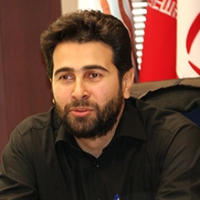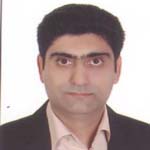The evaluation of DSSAT model for simulating wheat grain yield under different chemical and organic fertilizer application
Plant growth and production models are great tools to study variation of irrigation and fertilizer application and those impact on plant performance. Due to the fact that applying different scenarios of fertility and irrigation in field conditions is time consuming and costly, the use of plant models is a good solution for simulating and estimating the crop yield in different conditions. The accuracy of the results obtained from the simulation models depends on the accuracy of the data required by the model and if the input data is measured and determined accurately, the model will be applicable in different conditions after calibration and validation. Due to the great effect of using different types of chemical and organic fertilizers on plant growth and yield, it is necessary to compare and evaluate changes in wheat yield using chemical and organic fertilizers in order to improve soil and water productivity. Considering the different management scenarios of fertilizer use in DSSAT application model and the role of fertility in plant performance and also that the efficiency of this model in simulating plant performance in different management scenarios of chemical and organic fertilizer application is not clear, so in this regard the efficiency of DSSAT application model In order to simulate wheat grain yield in different application of fertilizer (chemical-organic) in order to increase yield and recommendations were studied and evaluated.
This research was carried out in the research farm of Karaj Soil and Water Research Institute at 35 and 50 north latitude and 55 and 30 degrees east longitude. In terms of climate, this region is one of the hot and dry Mediterranean climates with hot and dry summers and cold winters. 4 fertilizer application treatments in a randomized complete block design in 3 replications including control, without fertilizer application (T0), application of chemical fertilizers (nitrogen, phosphorus and potassium) based on soil test (T1), application of 20 tons per hectare of waste compost with fertilizer application Chemical nitrogen at 75% and phosphorus and potassium at 50% recommended based on soil test (T2), application of 20 tons of waste compost fertilizer (T3) were considered. In this regard, 4 plots with an area of 200 square meters were selected and after tillage operations including plowing, disc and land preparation, wheat was cultivated. The aim of this research was to investigate the efficiency of the DSSAT model in simulating wheat yield under different management conditions of chemical and organic fertilizer application.
Results showed that measured and simulated wheat grain yield in the control treatment (without fertilizer application) were 2.3 and 2 tons per hectare, respectively, and the corresponding measured and simulated values in chemical fertilizer application (NPK fertilizer application based on soil test) were 3.9 and 4.2 tons per hectare respectively. In terms of compost application at a rate of 20 tons per hectare, the average simulated and measured grain yield was about 3.1 and 2.9 tons per hectare, respectively. Flowering and ripening phonological time of wheat were 192 and 227 days after sowing, respectively, which is in close agreement with the simulated values, which are 190 and 230 days, respectively. RMSE, NRMSE, EF and d of DSSAT model for grain yield were 0.38, 0.13, 0.57 and 0.93, respectively, which indicates the high and appropriate performance of DSSAT(CERES) model in simulating wheat grain yield in different conditions of fertility managements based on application of chemical and organic fertilizers.
Due to the fact that applying different scenarios of fertility and irrigation in field conditions is time consuming and costly, so the use of plant models is a good solution for simulating and estimating the crop yield in different conditions. The results of the statistical indices showed that the appropriate performance of DSSAT model in simulating wheat grain yield in different conditions.
-
Investigating and matching the stages of plant growth with growth degree day index (GDD) based on the native phenology information of Wheat, fodder Corn and Sugar beet in water requirement system (NIAZAB)
*, Niyaz Ali Ebrahimipak
Journal of Crop Production Research, -
The Effect of Long-Term and Integrated Application of Organic and Chemical Fertilizers on the Production of Wheat (Triticum Aestivum L.) in Fixed Plots
Alireza Jafarnejhadi *, , Fatemeh Meskini-Vishkaee
Applied Soil Reseach, -
Using of Hydrus 2D model for proposing suitable irrigation scheme and simulating soil salinity (Case study of Semnan pistachio orchards)
*, Mohammadreza Emdad
Irrigation & Water Engineering, -
Studying the accumulation of heavy metals in the soil as a result of multi-year application of municipal waste compost using modeling
Seyed Majid Mousavi *, Hamed Rezaei, Azadeh Sedaghat, Leila Esmaeelnejad, Pouria Tohidtalab,
Iranian Journal of Soil and Water Research, -
Integrated Soil and Water Management at Farm Level in Honam Sub-Catchment(Part II: Soil and Water Recommended Packages for Homogenous Units)
Mohammadreza Balali *, Sina Mallah, Kamran Eftekhari, Hamed Rezaei, Kambiz Bazargan, Vinay Nangia, , Mehdi Panahi, Morad Sepahvand, Abdollah Mumvandi, Morad Ghanbarpouri, Samad Abdi, Masoumeh Matinkia, Mahnaz Sepahvand, Morad Azizollahi
Iranian Journal of Soil Research, -
The effect of the method and stage of zinc and iron micronutrients application on some characteristics of physiological, qualitative and fruit yield of Yaghouti grapes
Mansour Fazeli Rostampour *, Mohamadreza Pahlavan Rad, Seyed Ali Ghaffari Shahre Babaki
Soil Management and Sustainable Production,





